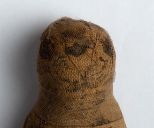At face value
Zooming in on the face of this mummy, we can discern some strange black markings. Although the mummy is human-shaped (it even has feet!), it is very small, only about 24 centimetres long. We can find a clue as to the contents in the markings on its head: they do not depict a human face. It might not be clear at first glance, but these are actually the facial features of a falcon, as is often rendered in ancient Egyptian art (also compare figures 2 and 3). In this particular case, the features are a bit odd-looking, but still recognizable.
Judging from this fact, we may conclude that this small mummy contains the remains of a falcon. Falcons were considered sacred animals in ancient Egypt, mainly because of their association with the falcon(-headed) god of kingship, Horus (fig. 4).
Let’s take a closer look at the mummy and find out more.

](https://micrio.thingsthattalk.net/drZMc/views/max/128x128.jpg)
](https://micrio.thingsthattalk.net/BEfGT/views/max/128x128.jpg)
](https://micrio.thingsthattalk.net/okayZ/views/max/192x128.s.jpg)